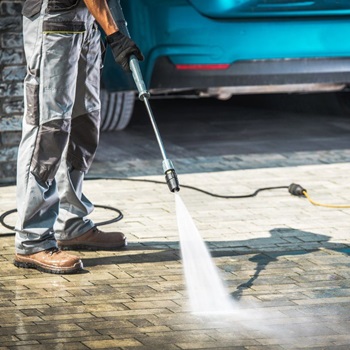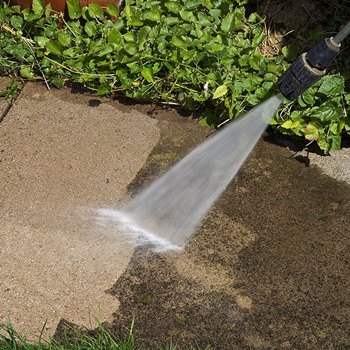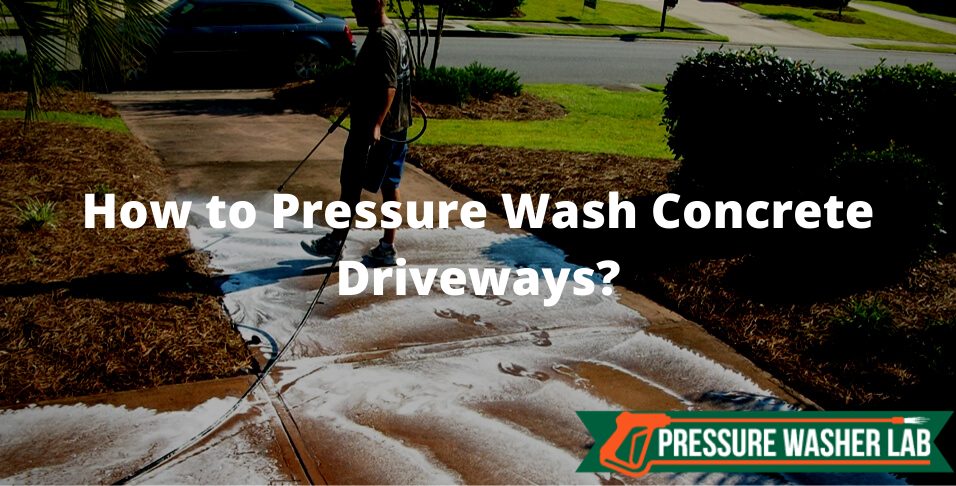Pressure washing concrete driveways can be performed as follows:
- Prepare the area and follow the safety measures needed to pressure wash concrete driveways.
- Set up the pressure washer, attach the nozzle, and set the pressure rates accordingly.
- Remove the stains from the concrete driveway before starting the pressure washing job.
- Spray clear water on the entire area using the pressure washer.
- Apply a concrete cleaner using a pressure washer on smaller sections until all the area is covered.
- Rinse the detergent by directing the chemicals to a sewer.
What materials are needed to pressure wash concrete driveways, the safety measures that need to be taken while performing the job, and the steps needed to perform deep cleaning are discussed in detail below.
Supplies Needed to Pressure Wash a Concrete Driveway
 Pressure washer
Pressure washer- Garden hose
- High-pressure hose
- Pressure washer trigger gun
- 25-degree nozzle, pressure washer broom, or surface cleaner
- Soap nozzle
- Pressure washer detergent
- Safety goggles
- Leaf blower or broom
Safety Tips for Pressure Washing Concrete Driveways
Pressure washing concrete driveways requires the operator to adopt some safety measures that refer to both the user as well as the surface and the area nearby. These safety measures are as follows:
- Never pressure wash concrete driveways while barefoot or in sandals or slippers.
- The use of safety goggles is indicated to eliminate the risk of severe injury.
- Thermal protective gloves are recommended while using a hot water pressure washer to clean concrete driveways.
- Long pants and long sleeves should be worn while pressure-washing concrete driveways.
Area Preparation
Before pressure washing a concrete driveway, it is recommended to prepare the area in order to avoid damage and to decrease the risk of injury. Area preparation should be done as follows:
- All objects present on the driveway should be removed until finishing the job.
- The plants in the nearby area need to be covered with a tarp to avoid damage due to high-pressure water or detergent contamination.
- The area should be swiped with a broom to remove debris, small rocks, and pointy objects, such as needles. These items could cause severe injuries if propelled by the water that comes from the pressure washer. If this process takes too long because the area is large, removing debris should be done using a leaf blower.
How to Set Up a Pressure Washer for Pressure Washing Concrete Driveways?
Setting up the pressure washer for concrete driveway cleaning is the same as for any other task. This step requires the operator to connect the garden hose to a water supply at one end, and to the pressure washer, at the other end. This step has to be taken only after attaching the high-pressure hose, pressure washer trigger gun, and nozzle to the power washer. Our article on how to start a pressure washer discusses this process in detail.
PSI
The pressure rate recommended for concrete driveway power-washing is between 3000 PSI and 3500 PSI. Such high pressure requires the use of a gas pressure washer or of a highly powerful electric unit. Due to higher mobility levels, a gas pressure washer is ideal.
Nozzles
Pressure washing concrete driveways using a green nozzle is highly recommended. This power washer nozzle has a 25-degree spray angle which comes with reduced pressure and large coverage.
Pressure Washer Concrete Cleaners
While pressure cleaning concrete driveways, the use of a specially formulated chemical for concrete is essential. The following aspects need to be considered: the chemical used should be formulated for concrete surfaces, and the chemicals should be formulated for pressure washer use. The former aspect is essential, as many cleaners that don’t have this specification contain high amounts of bleach or other substances that could permanently deteriorate a pressure washer. The use of a pressure washer concrete cleaner is recommended regardless of the type of unit used.
Cleaning a Concrete Driveway with a Pressure Washer – Steps
Step 1. Remove the stains present on the concrete driveway.
 Removing stains from a concrete driveway can be done by spot cleaning using a sprayer or by using the pressure washer. Using a pressure washer is recommended in case there are many stains present or if the stains are old. While using a pressure washer, the use of the 25-degree nozzle and clear water is recommended, as nozzles that have narrower spray patterns might damage the driveway. If clear water is not enough, use a detergent suited for the type of stain that needs to be removed, or a concrete cleaner that has a general-purpose.
Removing stains from a concrete driveway can be done by spot cleaning using a sprayer or by using the pressure washer. Using a pressure washer is recommended in case there are many stains present or if the stains are old. While using a pressure washer, the use of the 25-degree nozzle and clear water is recommended, as nozzles that have narrower spray patterns might damage the driveway. If clear water is not enough, use a detergent suited for the type of stain that needs to be removed, or a concrete cleaner that has a general-purpose.
Grease or stains that are new can be removed using a powder spill absorber before pressure washing them. Paint stains can be removed by applying a paint stripper and scrubbing them manually in case the pressure washer is not strong enough to remove them with clear water. Rust stains and dirt can be easily removed by applying concrete cleaner using a pressure washer, so removing them can be done while pressure washing the entire area.
Step 2. Spray clean water on the concrete driveway using a pressure washer.
This step needs to be taken before cleaning the concrete area with a power washer. The role of this procedure is to detach the debris from the concrete using pressure. This procedure should be done by covering small areas starting from the most faraway distance. Before spraying the area, make sure that the right pressure is used by testing it on a small area.
Step 3. Apply the concrete cleaner to the surface.
Before applying chemicals using a pressure washer, pour the concrete cleaner into the detergent tank. Change the currently used nozzle to a black soap nozzle. Make sure that the pressure washer is turned off before doing this otherwise, the risk of injury is really high. Clean small areas and let the detergent soak in as instructed by the chemical producer, then change the nozzle again and rinse. Move on to the next section.
Pressure washing concrete driveways can also be done by using a pressure washer broom or a surface cleaner. The best results are obtained when using the former one. A surface cleaner is a pressure washer attachment that is equipped with multiple nozzles to get the cleaning job done faster than with a regular nozzle. The difference between a surface cleaner and a pressure washer broom is that it has a casing that does not allow the water to get the operator wet. More information on surface cleaners can be found in our pressure washer surface cleaner buying guide.
Step 3. Remove all detergent residue from the pressure washer.
Removing the detergent and all detergent residue from the pressure washer has to be performed before rinsing the concrete cleaner using the power washer. This can be done by emptying the detergent tank of the cleaning unit, and running the power washer for a few cycles until the water spray is chemical-free.
Step 4. Rinse the concrete cleaner using the pressure washer.
This step needs to be performed by directing the water and chemicals to a sewer or fosse. If this is not possible, start from the first section where detergent has been applied and finish with the last.
Step 5. Wait for 24 to 48 hours before sealing the concrete driveway.
Applying a concrete sealant is optional and the area needs to be completely dry before doing this, as the sealant will not adhere to the concrete otherwise.

